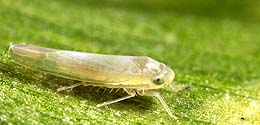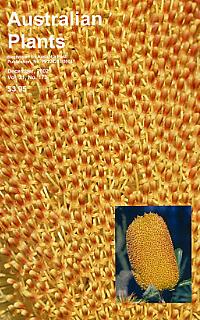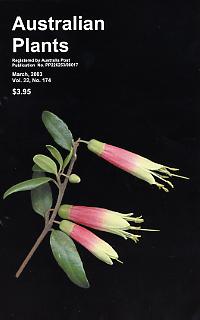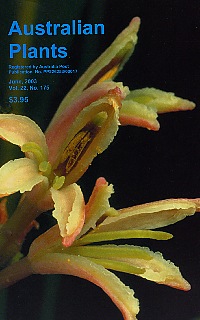"Paws" is a new, free e-newsletter published by the Foundation for National Parks and Wildlife. Issue 1 was published in Spring 2003 and Issue 2 has just been released. The newsletter features articles on a wide range of topics centered on the Foundation's projects. Issue 2 includes:
Although centered on New South Wales, "Paws" should be of interest to anyone interested in the natural and cultural environment. You can subscribe to "Paws" through the Foundation's web site.  Biological control slows creeping assaultTen years of research is finally slowing the advance of bridal creeper, one of Australia's worst imported weeds. Researchers have released three biological control agents from South Africa, the original home of the weed. "The results are very encouraging with reports of natural spread of the rust fungus of up to 360 metres from release sites after one year and up to 2.5km after three years," says CSIRO Technical Officer Kathryn Batchelor, who has been responsible for the rearing and distribution of the insect agents in Western Australia.
"We have released a leafhopper (Zygina sp.) in 1999, a rust fungus (Puccinia myrsiphylli) in 2000 and, in WA, a leaf beetle (Crioceris sp.) in 2002," says Ms Batchelor. "These agents only attack bridal creeper." Bridal creeper, introduced from South Africa in the 1800s as an ornamental plant, escaped and is now one of southern Australia's worst environmental weeds, strangling large areas of natural vegetation and threatening biodiversity, including rare and unique native plants, especially orchids. "The rust fungus and leafhopper defoliate plants," says Dr Louise Morin, a plant pathologist with CSIRO and the CRC for Australian Weed Management. "This depletes the reserves in the massive underground mat of tubers. The larvae of the leaf beetle stop the creeper climbing by stripping off its shoots and leaves." "It is an exciting project," she says. "Schools and community groups have been involved in more than 1500 releases of the rust fungus and leafhopper across Australia, and 2003 saw the first releases of the leaf beetle in NSW and South Australia. Anthony Maguire, National Parks and Wildlife Officer on Kangaroo Island (SA), says the rust is working well on Kangaroo Island. "It's been two to three years since the first release here and we can already see a significant reduction in the density of bridal creeper," he says. "Now we are testing new methods of spreading the rust." Dr Morin says that recent Natural Heritage Trust funding has enabled significant advances in the attack on the creeper right across southern Australia. CSIRO has developed a web site and held training workshops across the country to help people redistribute agents into infestations in their local area. CSIRO Media Release For further information on bridle creeper and efforts to control its spread, see CSIRO's bridle creeper website.  Bushfires change soil chemistryCanberra students have joined university researchers from ANU School of Resources, Environment and Society to find out just how much damage the January bushfires have done to the region's soil. "We're looking at the difference in soil chemistry between a burnt and unburnt section of the forest," says Chrissy Anderson-Smith, a Year 11 student from Canberra College.
"Changes to soil chemistry affects the nutrient value of the soil, with a cascade of effects right through the ecology of the forests. And these changes will vary depending on how intense the fire was. "We're particularly interested in the longer term consequences for the forests, both the plantations and the native forests." Students taking part in the College Symposia project organised by the Researching With Scientists Project (a collaboration between CSIRO and the ACT Department of Education, Youth and Family Services) are working with science teachers and university researchers on a number of projects, designed and undertaken by the students. The projects include:
CSIRO Media Release  Australian Plants AwardAt each ASGAP biennial conference, the work of dedicated people who have advanced the cause of the Australian flora in some way are recognised through the Australian Plants Award. The Award has both a Professional and an Amateur category. At the 2004 Launceston Conference, in the amateur category, two awards will be given, as the judges did not want to differentiate between Irene Champion and Marion and John Simmons. The citations follow. Irene Champion - Amateur CategoryIrene was nominated by SGAP Queensland Region for the large contribution she has made to the Society and to Australian plants in the Mackay District. She has been a member of SGAP Qld Region for 27 years and helped form the Mackay Branch in 1978. She was elected Treasurer at the inaugural meeting, a position she held until she became Secretary in 1988. She has continued in this position ever since. Irene has always been a very active member of this branch, and has taken a major role in the organisation of meetings, excursions and projects. Irene has made a considerable contribution to the knowledge of the flora of this district through her own collecting activities and working with officers of the Queensland National Parks and Wildlife Service on botanical surveys. Although she started with no formal botanical qualifications she is now recognised as an authority on the flora of this region and has contributed over 1000 specimens to the Queensland Herbarium. She has written several books and pamphlets to dissemi-nate this knowledge. Most of this work has been in a voluntary capacity, but she has also done some contract work in recent years. Irene has taken a leading role in several projects in Mackay including the Lagoons beautification, Slade Point Reserve, the Mackay Regional Botanic Gardens and the present Envi-rofund Project for the Mackay Wetlands. The Mackay Branch was a significant force in lobbying for the establishment of the Regional Botanic Gardens and Irene was invited by the Council to join the steering committee. The Botanic Gardens is now open and is a wonderful facility for this Region. Marion and John Simmons - Amateur CategoryJohn and Marion Simmons joined the Society 40 years ago and became inaugural members of the Northern Branch of SGAP Tasmania in 1976. In those early times there was less academic input into SGAP, and members relied on the knowledge of the individual members. John and Marion set the pace by leading field trips, writing articles and through leadership. Since then they have willingly shared their knowledge and experience with others and encouraged people who have shown interest in native plants. John and Marion have been active at Branch, Region and Federal level in the Society, holding various positions in the organisation. They have actively promoted Australian plants by involving their native garden in the Open Garden Scheme and have produced many articles for magazines, newspapers and newsletters as well as the book on acacias. Marion and John have contributed very significantly to promoting Australian acacias and advancing our understanding of these plants over the past two decades, Marion through her writing and illustrations and John through his photographs. They are renowned for their Australia-wide Acacia collecting trips. Marion has sent many collections of Acacia, primarily from Western Australia, to the WA Herbarium for checking. Now most of this material is incorporated into the Herbarium where it represents a valuable source of Acacia research. They have also contributed such material to other herbaria and to other collectors. According to Bruce Maslin, Senior Research Scientist, with the WA Herbarium, Marion and John have a very professional approach to their wattle studies. He has stated that their book, Acacias of Australia, volumes 1 and 2, represent examples of excellence that can be achieved by people driven by a passion and with an eye for beauty, and who possess the necessary knowledge, skills and dedication to bring such work to fruition. Nearly, one quarter of all Australian Acacia is included in the two volumes. John and Marion are acknowledged in the Flora of Australia for their work on wattles and the Wattle CD. Also in recognition of their work they have a wattle species named after them. Gwen Harden - Professional CategoryGwenneth Jean (Gwen) Harden is nominated by the NSW Region for the Australian Plants Award - Professional Category. Gwen's career as a professional botanist in both aca-demic and herbarium contexts has been recognised as that of a scientist of international standing. Her publications are respected as being of high scientific merit yet they are also accessible to, and readily useable by, the amateur and enthusiast. Gwen's professional work has not made her aloof from the lay person. She is a long-standing member of the NSW Region. She has been involved in the general activities of a district group within the Australian Plants Society and has readily shared her knowledge of, and enthusiasm for, Australian plants helpfully and patiently with members, particularly by leading or accompanying tours to areas of botanical interest. She has her Bachelor (with honours) and Master of Science Degrees from the University of New England, Armidale, where she tutored for a number of years. She has also tutored at James Cook University, Townsville. She joined the Royal Botanic Gardens Sydney in 1981 as a Botanist becoming pro-gressively a Senior Botanist and then Special Botanist. From 1994 to 2000, she was Curator Manager Herbarium, Royal Botanic Gardens Sydney, including periods of acting in the position of Senior Assistant Director Plant Sciences. According to Dr. Barbara Briggs, also regarded as one of Australia's leading botanists, Gwen's greatest botanical achievement is the Flora of New South Wales, covering 6605 species, which were identified, described and illustrated; the four volumes total 2860 pages. The first two volumes were published in 1990 and 1991 respectively and have been revised with new editions in 2000 and 2002; volumes 3 and 4 were published in 1992 and 1993. Gwen coordinated the work of numerous botanists, illustrators and photographers; for example, the revised Volume 2 involved 38 text authors and seven illustrators. While this was a team effort, Gwen contributed more than any other author, and planned, edited and coordinated the whole work. Without her expertise and dedication, the Flora would not have been completed. Those familiar with the Flora will know both about its quality, readability and use as a plant reference. She has also monitored the Wingham Brush rainforest regeneration project; coordinated the assessment of the World Heritage Values of the Blue Mountains and adjacent sandstone plateaus; published botanic research papers (naming and describing plant species); jointly authored books on rainforests; been an important student educator; and run workshops for community groups. Another colleague, Dr. Tim Entwisle, said that Gwen Harden became a botanist because she liked the great outdoors. In fact she liked it so much that she went to Armidale rather than Sydney University. After her nineteen years at the Gardens she returned to the bush, her beloved rainforests. From the ASGAP Newsletter, November 2003  Top information siteThe Victorian Department of Primary Industries has compiled a series of information guides that will be of assistance to anyone interested in Australian flora. The series covers both horticultural and revegetation topics - there is literally something for everyone. Here's a sample of what you will find.....
View the complete Notes information Series here.  "Australian Plants"....in print!The Society's 48 page, colour (printed) journal, "Australian Plants" has been published quarterly since 1959. It carries articles of interest to both amateur growers and professionals in botany and horticulture. Its authors include the leading professional and amateur researchers working in with the Australian flora and many beautiful and high quality photographs of Australian plants are published in its pages. Topics covered by the journal cover a wide range and include landscaping, growing, botany, propagation and conservation. A subscription to the print version of "Australian Plants" is $20 annually for 4 issues (overseas $AUS32) including postage. To subscribe, print out the Subscription Form and post or fax the appropriate fee to the address indicated on the form. Note that the contents of "Australian Plants" and "Australian Plants online" These are some of the topics covered in recent issues of "Australian Plants":
 Brian Walters [Front Page] [Features] [Departments] [Society Home] [Subscribe] Australian Plants online - December 2003 |








